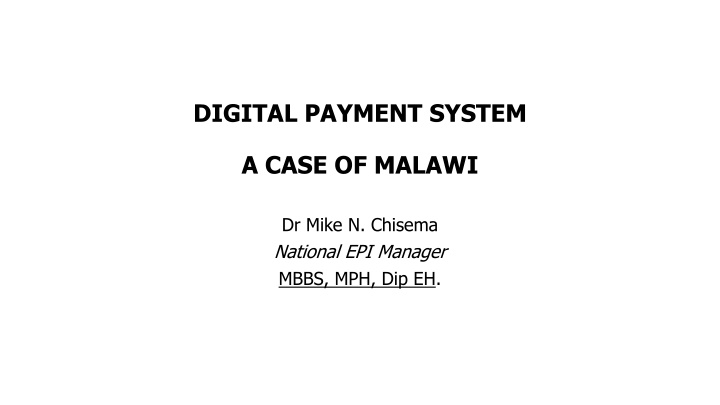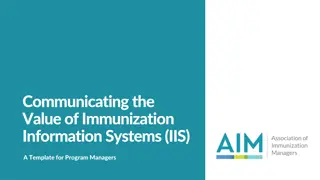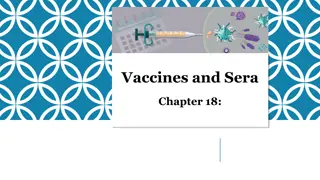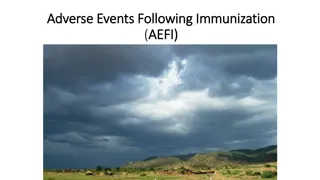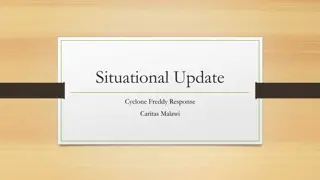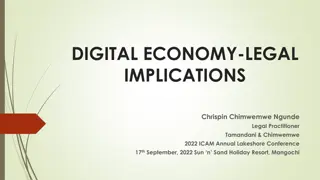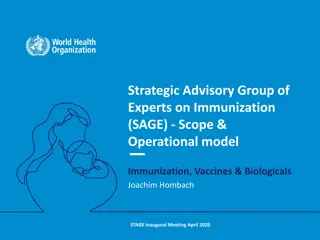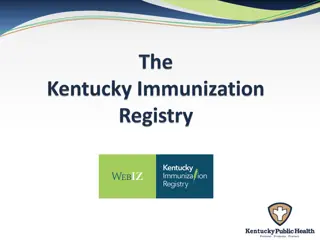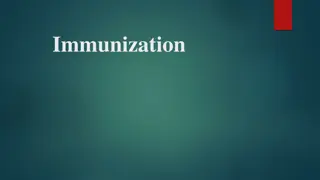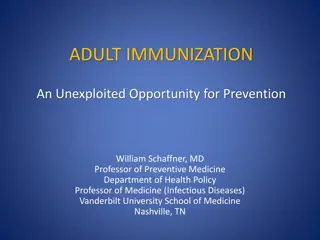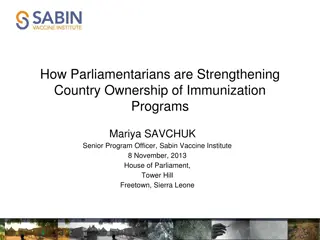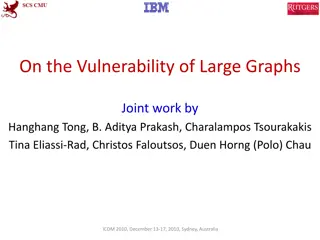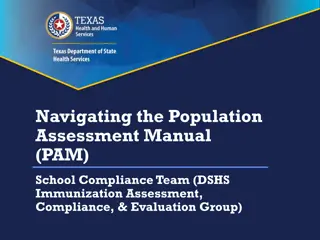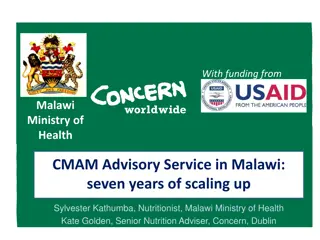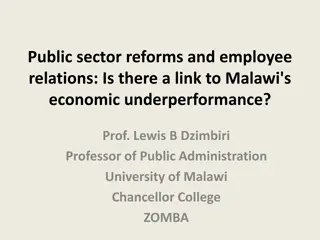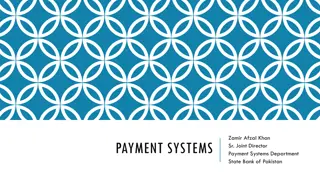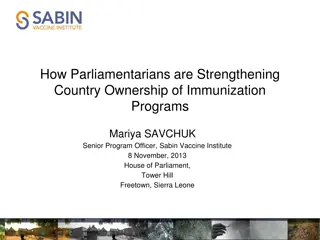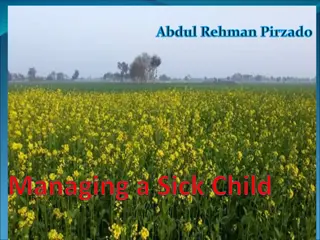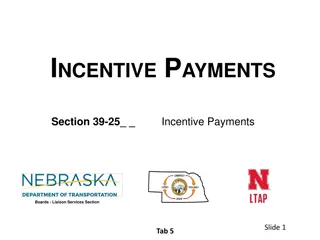Digital Payment System in Malawi: Improving Incentive Management for Immunization Campaigns
Enhancing quality in Supplementary Immunization Activities like Polio campaigns requires efficient human resource incentives. Implementing innovative digital payment systems in Malawi, spearheaded by Dr. Mike N. Chisema, is revolutionizing the way incentives are managed for beneficiaries through bank accounts or mobile money. The process includes beneficiary verification, payment integration for various services, and operational steps for successful mobile payment adoption, ensuring seamless transactions for stakeholders.
Uploaded on Oct 05, 2024 | 7 Views
Download Presentation

Please find below an Image/Link to download the presentation.
The content on the website is provided AS IS for your information and personal use only. It may not be sold, licensed, or shared on other websites without obtaining consent from the author.If you encounter any issues during the download, it is possible that the publisher has removed the file from their server.
You are allowed to download the files provided on this website for personal or commercial use, subject to the condition that they are used lawfully. All files are the property of their respective owners.
The content on the website is provided AS IS for your information and personal use only. It may not be sold, licensed, or shared on other websites without obtaining consent from the author.
E N D
Presentation Transcript
DIGITAL PAYMENT SYSTEM A CASE OF MALAWI Dr Mike N. Chisema National EPI Manager MBBS, MPH, Dip EH.
INTRODUCTION Human resource incentive are important for quality Supplementary Immunization Activity campaigns e.g. Polio Innovative ways of payment that reduces inefficiencies during payments critical Payment of beneficiaries through bank account or mobile phone numbers (mobile money) is one innovation All types of payment can be made: Payment of DSAs Payment of lunch allowances Payment for fuel Payment for services .i.e. refreshments during seminars
REQUIREMENTS AND PROCESSES Beneficiary should have functional bank account or registered phone number Beneficiaries should submit their full details, name, National identity very important Account details/mobile money details should be verified For mobile money, verification is done by telecommunication companies (Airtel or TNM) Verification may take 24-48 hours Always include mobile money charges Money transferred into mobile wallet of the beneficiary .i.e. vaccinator, volunteer
Process for Operationalizing mobile payment system Process for Operationalizing mobile payment system 1. Wild Polio Case Detection 2 Fund Mobilization (GPEI through WHO&UNICEF 3 3 Learning operationalization digital payment system F e b 2 0 2 2 4 Receipt of Technical and political support 5 Training of Community Health Care workers -SIA 6 Registration Process of community health workers 7 Verification of contacts of community health workers 8 Approval of Contacts 9 Payment of allowances Payment of allowances End Start ROUNDS 1-5
PAYMENT FOR PROCUREMENT/SERVICE Requires the company/business to be registered in the WHO system Registration includes bank details The system registers only businesses that are registered with the registrar general of Malawi Payment is issued after the service is offered
Coverage Coverage Children under 15 years were vaccinated 9,495,318 (107%) Children under five years were vaccinated 3,629,202(98.6%) LQAS: 20/29 (69%) of Lots passed at 90% coverage band compared to 72% in RD4 2022. Target population for next round 9,859,061 Total budget $5,695,565
Admin Data: 0-<15yr Coverage Rate Nationally, 107.1% of the target group (0-<15 yrs) have been vaccinated. 27/29 districts achieved the expected target of 95%. 7
Lot Quality Assurance Sampling Results (1/2) Failed Lots and missed children 69% Lots (20/29) passed the LQAS as against the target of at least 80% of lots. Of the total 1,740 sampled eligible <5 children, 104 (6%) missed the vaccination. Majority of the missed children (24%) were identified in CHIRADZULU district District Chiradzulu Mzimba North Nkhotakota Nsanje Neno Salima Thyolo Balaka Lilongwe Missed %Missed 25 8 8 8 6 6 6 5 5 24% 8% 8% 8% 6% 6% 6% 5% 5% Selected Settlements with missed children Children Missed District Facility Settlement CHIRADZULU CHIMWAWA Chapamba 4 CHIRADZULU CHIRADZULU DHO Malikampenya 1 CHIRADZULU MARAVI Chibwana 3 CHIRADZULU MBULUMBUZI Chitambo 9 CHIRADZULU NAMITAMBO Nkhuku 6 Legend CHIRADZULU NJULI Lulanga 2 Rejected Accepted No LQAS Done 8
Sample of activities Sample of activities Briefing meetings Trainer of trainers Immunization delivery training Microplanning Actual vaccination and mop up activities In process/end process monitoring of the campaign Lot Quality Assessment Sampling survey Supervision The other activities to do with Social Mobilization and Supply chain logistics are done by UNICEF and paid by cash
Raw statistics for the Polio campaign Raw statistics for the Polio campaign Total vaccination teams 18239 Vaccinators 18239 Total recorders 18239 Total Supervisors 4486 Total teams paid 36479 Total people paid 40965 The transmission of payments have been made we 100% success rate 18239 Social mobilizers and 1520 SM supervisors paid via cash (UNICEF)
DIGITAL PAYMENT SYSTEM ADVANTAGES Money goes direct to the beneficiary Reduces the risk that come with handling hard cash Convenient Cheaper DISADVANTAGES Requires account/mobile details before payment May result to unnecessary delay if no cooperation Requires all beneficiaries to have either account number or phone number registered on mobile money services May pay to wrong numbers and not easy to reverse Payment by default and not who worked at times
SUCCESSES We managed to pay 11,000 vaccinators and recorders during the three rounds of polio vaccination campaign in all 29 districts Used the same system to pay during oral cholera vaccination campaign in 8 districts Initial payment yields over 99% success rate with few returned due to mismatches or wrong account details
CHALLENGES Submission of wrong account or mobile details Mismatches on mobile details that usually lead to delay in payment The system requires cooperation of everyone including mobile service operators Resistance from some quarters as they still prefer the old system (cash payment)
Way forward Continuous engagement and improvement plans for the payment system Ensure data base is created and only work on updating beneficiary information Improve on beneficiary data storage to reduce back and forth verification and validation of individual data-time consuming
